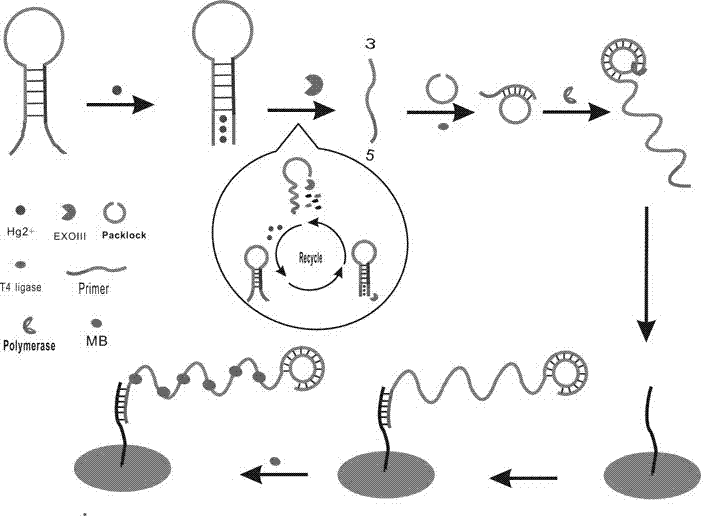Electrochemical sensor for detecting mercury ions
An electrochemical and sensor technology, applied in the field of biosensors, can solve the problems of high cost, cumbersome and time-consuming processing, and achieve the effects of fast reaction speed, improved sensitivity, and mild reaction conditions
- Summary
- Abstract
- Description
- Claims
- Application Information
AI Technical Summary
Problems solved by technology
Method used
Image
Examples
Embodiment 1
[0035] 1) The gold electrode is first polished in 0.3 μM and 0.05 μM alumina slurry until it becomes a mirror surface, and then rinsed repeatedly with PBS and secondary water;
[0036] 2) Add 10 μL of 10 μM capture probe dropwise to the electrode surface and incubate at room temperature for 2 hours; fix the sulfhydryl chain to the electrode surface through the Au-S bond;
[0037] 3) The main steps in a homogeneous reaction:
[0038] a. Add sterilized water, 10X buffer, 2μL exonuclease III, 2μL HAP with a concentration of 1μM and 2μL target substance (concentrations are 500nM, 200nM, 100nM, 1nM, 500pM, 100pM) to the pre-prepared In a sterilized centrifuge tube; shake for 30s, then put the mixed solution into a 30°C incubator and incubate for 50min;
[0039] b. Continue to add 2 μL 10 μM Padlock, 1 μL T4 ligase, 2 μL Phi29 polymerase and 2 μL dNTP to the centrifuge tube in step a; shake for 30 seconds, and then continue to incubate the mixed mixture in a 37°C incubator for 1 ho...
PUM
 Login to View More
Login to View More Abstract
Description
Claims
Application Information
 Login to View More
Login to View More - R&D
- Intellectual Property
- Life Sciences
- Materials
- Tech Scout
- Unparalleled Data Quality
- Higher Quality Content
- 60% Fewer Hallucinations
Browse by: Latest US Patents, China's latest patents, Technical Efficacy Thesaurus, Application Domain, Technology Topic, Popular Technical Reports.
© 2025 PatSnap. All rights reserved.Legal|Privacy policy|Modern Slavery Act Transparency Statement|Sitemap|About US| Contact US: help@patsnap.com

